Most people with chronic illness have experienced anxiety or panic at some point. It’s not always a condition on it’s own, but commonly is a symptom of other illnesses that affect the autonomic nervous system. There are many ways to reduce anxiety and stress, but today I will be sharing a fun and creative craft project that will help you restore calm to your world – the Twiddle Muff!
If you’ve ever met somebody with mental health or even chronic pain conditions, you have likely noticed that they tend to have habits like fidgeting or making repetitive movements or sounds. These actions are called stimming, they are an automatic response to stress or pain and they have a specific purpose. A Twiddle Muff can be a great tool in helping with this need.
Benefits Of Fidgeting or Stimming
Before I fell ill, I worked with children who have special needs, whether they had Autism or some other condition, they would each have their individual way of handling stress. Some made clicking or humming noises, others rocked their bodies back and forth and others rolled or spun things between their fingers.
As irritating as these noises and actions can be to people who haven’t experienced this themselves, it is so important that people be allowed to express themselves this way. If you try to stop it, they can go into a panic, because you’re taking away the thing that brings calm and control to their moments of anxiety and confusion and might be their only way of communicating their emotions if non verbal.
How Fidgeting Helps Me Personally
For me personally, fidgeting is something I have started doing constantly since being housebound with Severe ME. I used to only fidget (tap pencil, bounce a leg or click my nails) when nervous during exams or similar, but once I fell ill it became more frequent.
I have developed restlessness so I fidget constantly now and when I am forced to go out for appointments I am bombarded with sensory stimuli that cause anxiety, confusion, disorientation and pain. Fidgeting or stimming is one way to create calm and order in the chaos with controlled, repetitive movement and sensory stimulation.
I started rocking when in pain, clicking my nails and rubbing the tiny beads in my support cushion together when overwhelmed, but it would drive people to frustration as the constant rubbing together of the beads or clicking of my nails is irritating to people around me.
Since discovering Twiddle Muffs and making one for myself, I have found it provides all the stimulation and distraction I need – and it’s quiet.

Pin This Post!
Having something tactile to focus on is a great distraction and has a calming effect.
It’s reassuring because it creates a constant, something predictable, a pattern or texture to focus on when my mind hops constantly from one thing to the next without sense during episodes of cognitive dysfunction or brain fog.
Or if my pain is so intense that I need a distraction, or if the restlessness, creepy crawly feeling or tremors become overpowering and I can no longer think clearly.
The tactile stimulation and repetitive movements really do help to focus and stay calm.
What Is A Twiddle Muff?
Much like a hand-warming muff, a Twiddle Muff is a cylindrical item made of wool, yarn or fabric which you can insert your hands into – one from each side – and they’ll meet in the middle. We often see hand muffs in winter movies, and they’re usually made of fur.
A Twiddle Muff, on the other hand, is usually textured and colourful and has quite a different purpose. Most commonly recommended for use by Dementia patients, a Twiddle Muff can be very comforting and a great distraction for those who struggle with anxiety or disorientation.
Twiddle /ˈtwɪd(ə)l/
verb 1. twist, move, or fiddle with (something), typically in a purposeless or nervous way. “she twiddled the dials on the radio”
synonyms: turn, twist, swivel, twirl, adjust, move, jiggle
noun 1. an act of twisting or fiddling with something: “one twiddle of a button”
Although these cosy and colourful items are marketed towards people with Dementia, many others could benefit from using them too. People with Autism, ADHD, Social Anxiety, Panic Attacks, sensory overload and many chronic conditions would greatly benefit from having a tactile distraction from otherwise chaotic moments.
Since the Twiddle Muffs are usually decorated with a variety of embellishments, things like buttons, tassels, zips and pockets, they provide an array of fidgeting opportunities, both on the inside and outside of the muff, most of which are silent and discreet – unlike fidget spinners that whirr while spinning, or the clicking of my nails, creating sounds that attract attention and irritate others.
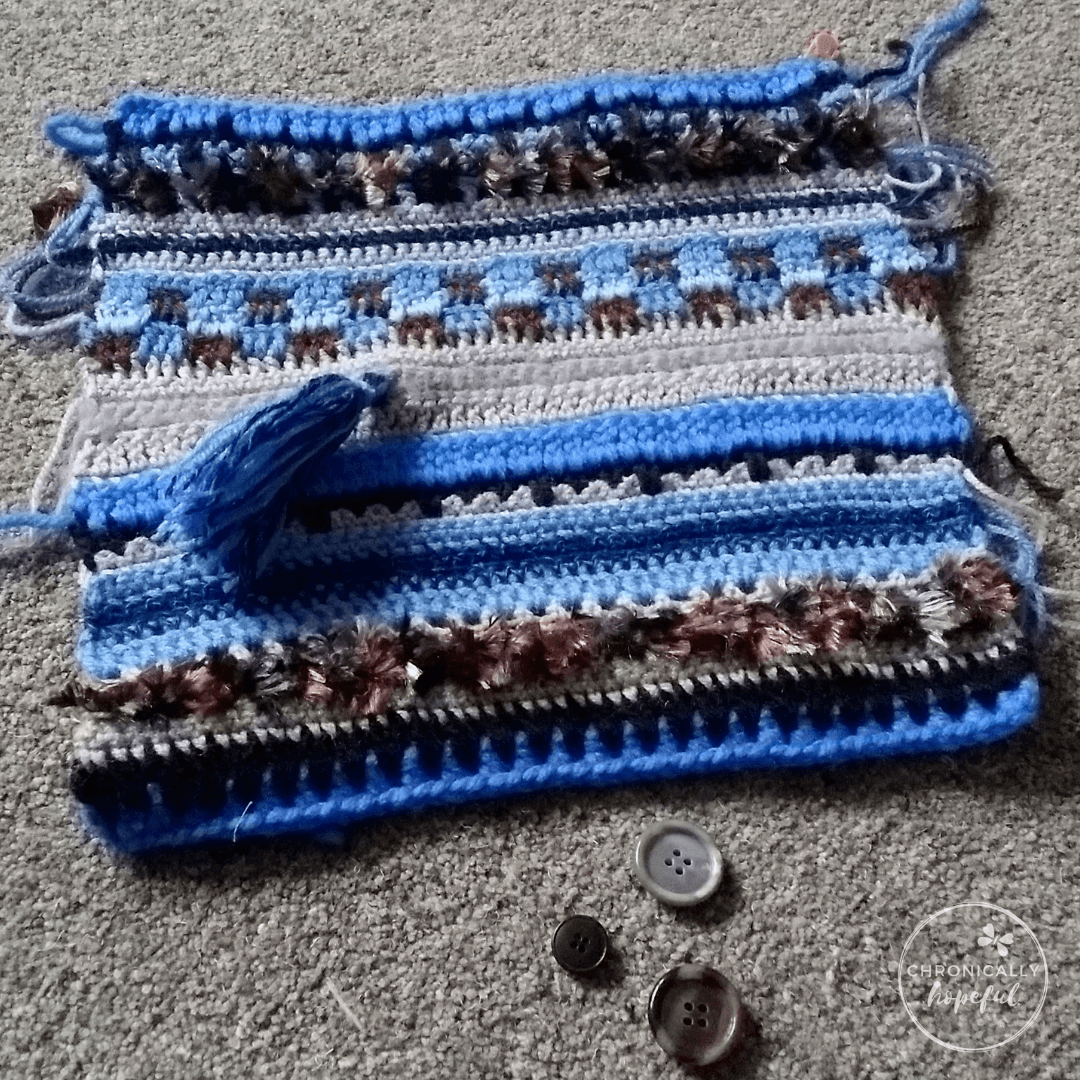
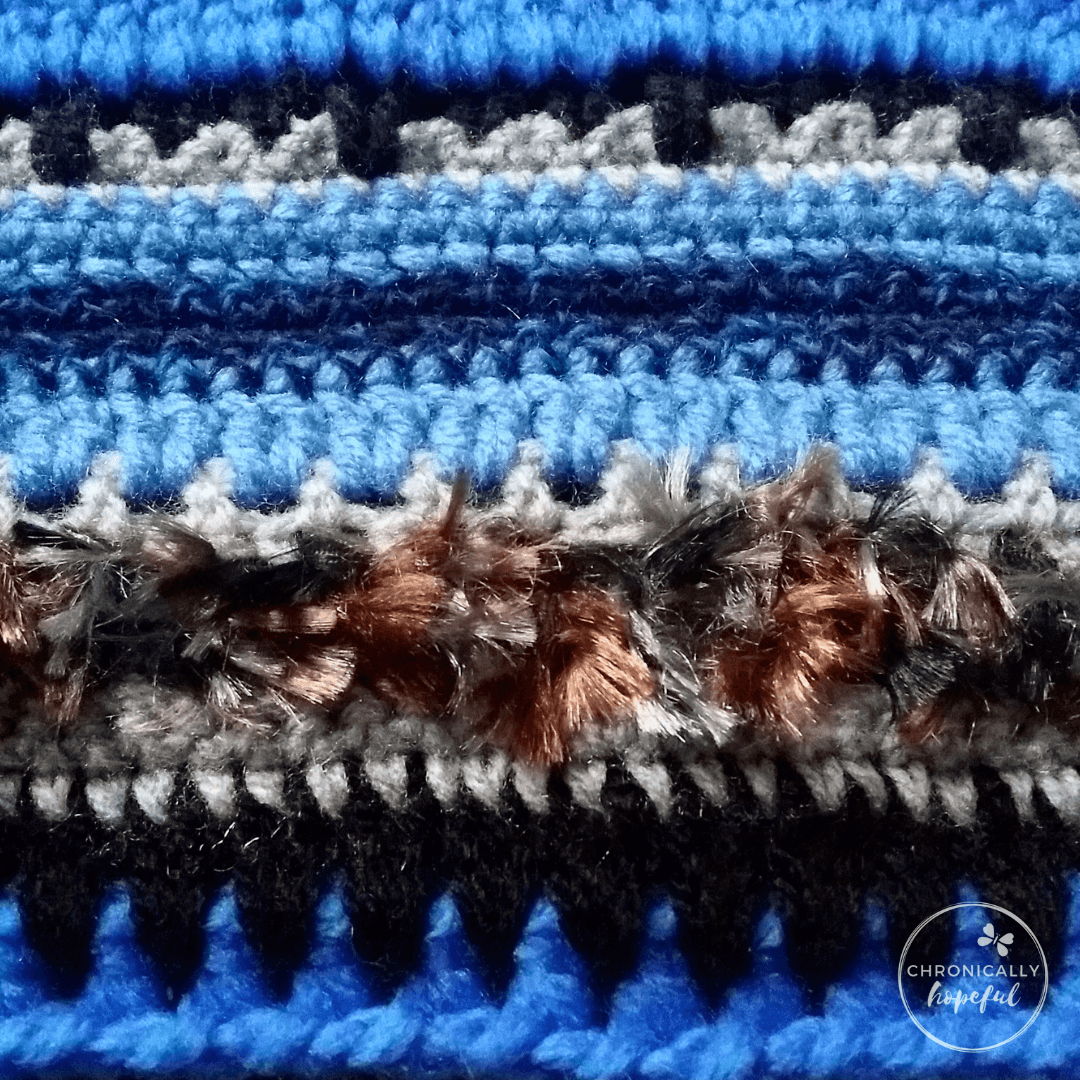

My Twiddle Muff has textured buttons of various sizes and materials (plastic, wood, metal), a rope that’s been threaded through the width of the muff as well as tassels.
The muff itself is made with a variety of yarns in different thicknesses and textures. Some fluffy, some scratchy, some thick and soft while others are bumpy or stiff. For my first one I used colours that calm me like blues and earthy browns and greys. The second one I made was much brighter with a rainbow of colours.


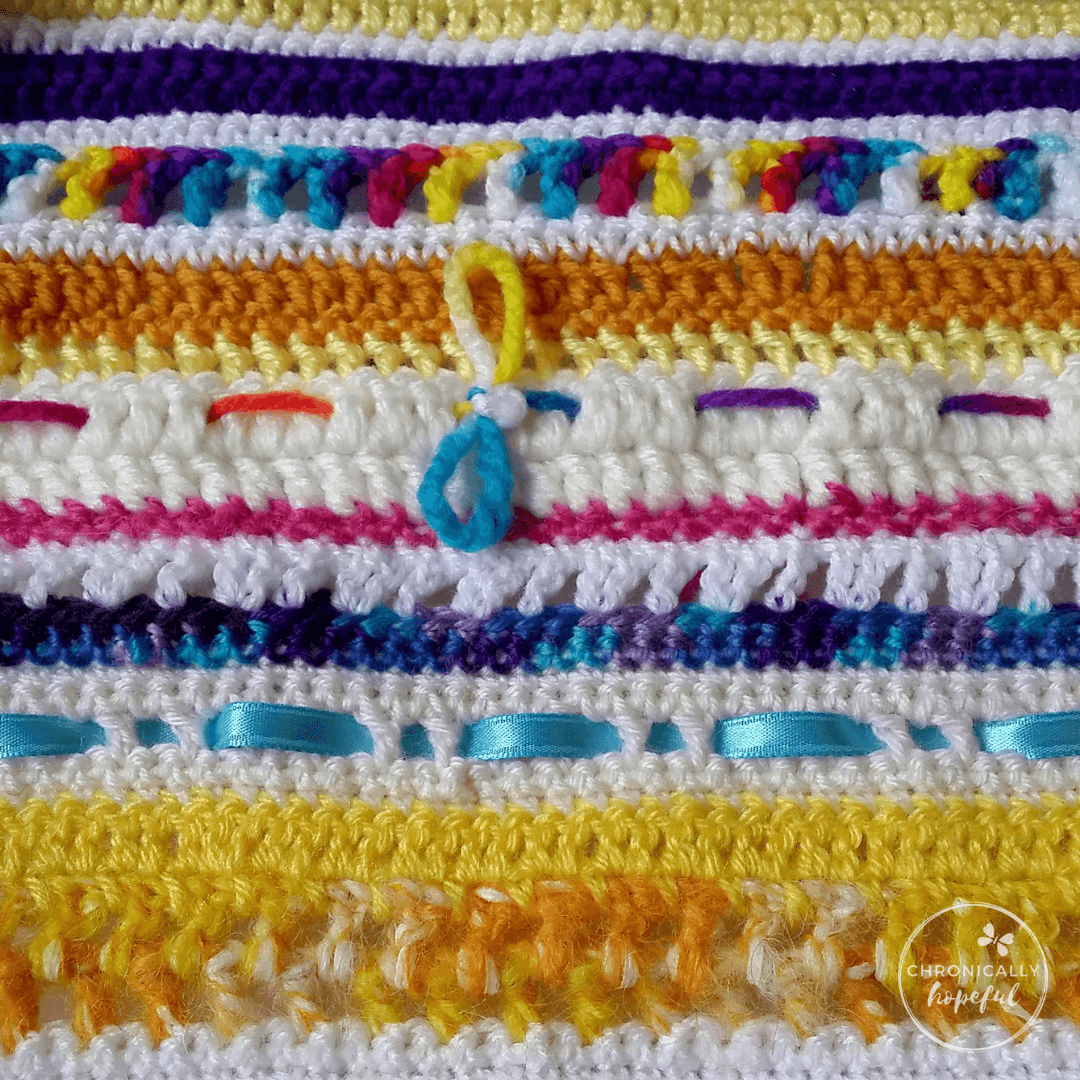
I love the idea of creating a unique and personalised muff that will not only keep my hands warm in cooler weather, but will also become a staple in my care kit. Providing calm and distraction in those chaotic moments when my symptoms and surroundings become too much to handle.
How To Make A Twiddle Muff For Anxiety
I do not use an exact pattern, but simply crochet any patterns I want until I reach the size I want it to be in the end. I love the flexibility of crocheting freely, as you can see in my photos, I switch up stitches and yarns every couple of rows.
This page contains affiliate links. This means I will make a small commission, at no extra cost to you, should you make a purchase after clicking on one of my links. Thank you so much for your support!
Supplies
- crochet hooks – I used a couple of different sizes, it depends on the yarn you choose. Read the recommended hook size on the yarn’s label for best results.
- a variety of yarn – this is a great project to use up scraps leftover from other projects.
- buttons, charms, beads, tassels – decorations to add interest and sensory stimulation.
Method
- Cast on until you have a row of stitches equal to the width of your hand at its widest plus about 6cm for wiggle room, then double that.
How I measured mine: I lay my hand flat on a ruler to measure across the palm of my hand and thumb, it’s just about 10cm. So my calculation is 10 + 6 = 16, then 16 x 2 = 32. So the width of my crocheted rectangle must be 32cm.
- You then crochet any pattern of stitches and colours you want, as long as the width stays the same. For Example: Starting with one yarn, you can do just one row, or a couple of rows, before switching to a new yarn or colour and you can change up the stitches or repeat the same pattern with the new yarn. Be as creative as you want to be with your patterns, just have fun with it!
- You stop when your rectangle reaches a length of about 30cm – 40cm. This will depend on how far you want the muff to go past your wrists. My hands are never stretched or open in the muff, but closed as I hold onto buttons or rub the tassels between my fingers, so 30cm goes over both my wrists.
- Now it’s time to sew on all your decorations – all the bits and bobs that add colour and texture for sensory, visual and tactile interest (see below for more ideas). Add some on the inside and the outside of your muff. Make sure to secure them very well.
- Once you’ve added all your fidgety bits, it’s time to sew up your muff. Fold it in half, inside-out, and stitch up the 2 edges to create a cylinder. Turn it out again and you’re done!
Adding Interest To Your Twiddle Muff
Here are a few ideas for decorations that will add fidgety goodness to your Twiddle Muff. The idea is to add things that have different textures and purposes: to distract, engage or occupy, calm or comfort your mind when things feel overwhelming. Some things like:
- buttons – wood, metal, plastic
- beads and gems
- colourful zips
- key rings to hang things on to
- lobster clasps to hook things onto the keyrings
- pendants or charms
- ribbons or cords woven through, something to tie or knot
- felt objects – flowers, animals, shapes, etc
- tassels – yarn, leather, etc
- you can even create pockets to hold tiny treasures!
Make sure everything is sewn on well else they will come lose over time with all the fidgeting.
Add Meaning, Sentimental Value & Familiarity
Something to consider for people with Alzheimer’s, is that these decorations can also hold much significance if they are familiar or linked to pleasant memories. They can add meaning or sentimental value if they include items from the person’s life or their loved ones. For example buttons from a spouse’s coat or bits of fabric from their favourite dress or shirt, etc.

Pin This Post!
Additional Ways To Use A Twiddle Muff
I think a Twiddle Muff is not only an excellent alternative to the fidget spinner for anxiety and restlessness, but also for those of us who are not allowed to have pets for whatever reason.
There are some fantastic natural fibres which would add a lovely fluffy feel to the Twiddle Muff. Having something soft and fluffy to hold and rub is a good alternative for a pet-free home.
Some people even make felted muffs and add animal faces to them. A sort of plush.
You could also add aromatherapy or essential oils in a little pocket or on a clay bead to help with a variety of symptoms.
When it comes to creating your muff, the sky is the limit with how creative you can be!
What About You?
- What are your habits when you are anxious or stressed?
- Have you ever used a Twiddle Muff or fidget toy for anxiety?
- Which are your favourites?
Related Resources
- NHS Requests Volunteers To Create Twiddle Muffs For Dementia Patients (PDF)
- Video: How To Knit A Twiddle Muff (instead of crochet)
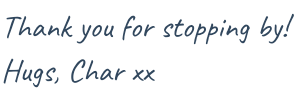



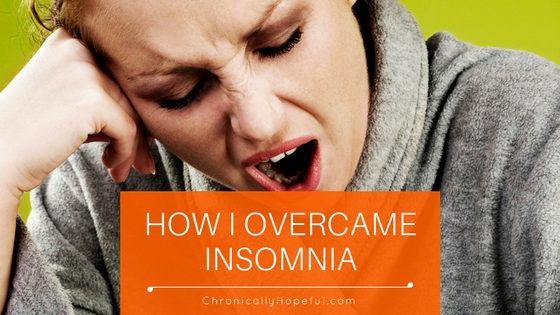

A lot of knitting groups make these and donate to hospitals which is such a lovely thing to do!
Yes! They are a great support item. I initially started making them to donate to dementia patients, but then used one and realised it really helped me too!
My first time visiting your blog… read a couple of posts…and others marked as to read… this one especially is an eye opener! Brilliant new thing learnt today..spreading the word on this! Swati Rai
Hi Swati! Thanks for stopping by. Glad you found this one interesting, is it something you could use or know somebody who might? Thank you for sharing x
Brilliant idea.
It really is! I’m so glad I stumbled upon these last year x
Love this Char….sharing to Monday Magic blog share tomorrow, Claire x
Ah, thanks Claire! ?
Great idea. My Dad is now in a dementia unit. One of the lady’s received one for Christmas from family overseas. As my Mum is always knitting or crocheting she thought she liked to try making one or two or three
( she never stops at one ). Found your site which was very informative about why they are so useful & great ideas on how to go about making one. Thanks.
Thank you so much for the feedback! I’m so glad you found this post helpful. I hope your mum will enjoy making them as much as I do. Such a creative activity to make and then so very useful too.
Need to start one for a friend that is so sweet and anxious. Her birthday is next month so I’d better get crocheting 💜Thx and God Bless you and yours… LisaS
That would make a lovely thoughtful gift. I’m sure she will love it!
Thank you for sharing this. I do adult programming at a library and this will make an awesome program. Hope you don’t mind if I share.
Hi Beth, I’m glad you like this post – sounds like a great idea to share with at the library. Such a fun and easy project to do and a great way to use up leftover bits and pieces from other projects.
What is there more a request for Twiddle muff or Twiddle Sleeve?
That is a good question. I think the best way to know would be to contact the care home, hospital or charity you want to donate the items to and see which they find most useful for their patients or members. It might vary from area to area or between different demographics or conditions.
I have a different pattern to crochet these. I like to add pockets on mine. I have made many and am always looking for places and people to donate them to. Happy to see your pattern and glad that it helps you!!
What a lovely idea to add pockets! Thank you for sharing.